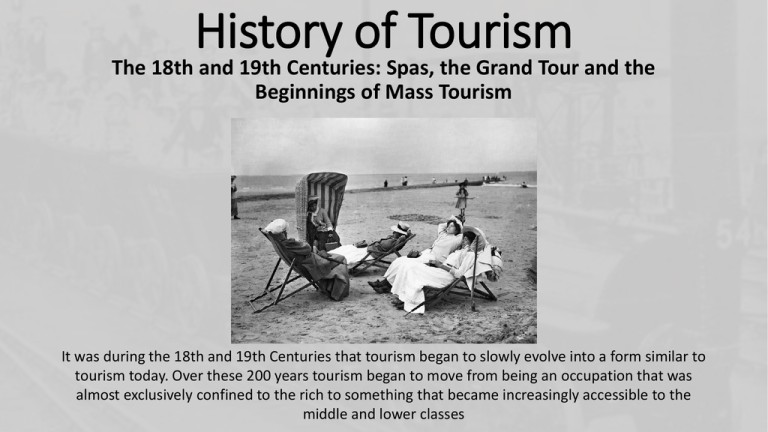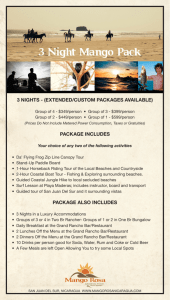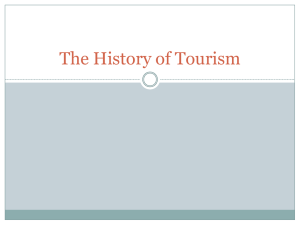PPT4 - US24724 - 18th and 19th Century
advertisement

History of Tourism The 18th and 19th Centuries: Spas, the Grand Tour and the Beginnings of Mass Tourism It was during the 18th and 19th Centuries that tourism began to slowly evolve into a form similar to tourism today. Over these 200 years tourism began to move from being an occupation that was almost exclusively confined to the rich to something that became increasingly accessible to the middle and lower classes The 18th and 19th Centuries: Spas As we already know Ancient Romans travelled to what is now modern day Bath in order to bathe in its thermal springs. The Romans believed that these waters had medicinal properties. However it was in the late 17th and early 18th century that the idea of the thermal spring as a tourist destination really came into its own, Many people, including medical personnel, believed that drinking or bathing in thermal waters was helpful in healing anything from anxiety to leprosy, What makes spas interesting in terms of the tourism industry is not only the return of travel for health reasons, but also the development of these sites as attractions, with their own facilities and particular clientele (a target market if you like). The 18th and 19th Centuries: Spas BATH BADEN-BADEN Bath is located in the South West of England on the River Avon 2Okm South East of Bristol and contains Britain's only natural hot springs. For centuries this natural phenomenon has attracted visitors to Bath and led to a unique historic urban environment around the springs Baden-Baden is nestled at the foot of the Black Forest in Germany. Like Bath, it was known for its hot springs and their invigorating properties. BadenBaden was also used by the traveling Romans; the restored ruin of a 2000year-old Roman bath once used by soldiers was discovered and excavated in 1857. The impact spas have had on how our tourism industry looks today... - The idea of travelling for health - Increased convenience of roads\access building tourism - Patronage of famous people increasing the attraction of a particular site - Development of facilities around a tourist attraction to cater for visitors who are not currently using the attraction e.g. hotels, casinos - Development of facilities to enhance an attraction, e.g. mud packs - Fostering of new attractions out of existing attractions, e.g. gambling and horse racing - Exclusion of local people and\or poorer people from exclusive sites - Employment of local people within site facilities Examples of this sort of tourism development in the modern world ALMOST ANY WORLD TOURIST ATTRACTION! Here's two examples: - Paying to visit Blarney Castle in Ireland, where local people are employed helping visitors 'kiss the Blarney Stone' . https://www.youtube.com/watch?v=Zbv6hliU8CM - The development of thriving amusement parks on the Gold Coast in Australia that visitors attend when they're not on the beach. https://www.youtube.com/watch?v=CMW1rBvYcdw The 18th and 19th Centuries: The Grand Tour - Travel as a learning experience… In a similar period to the commercialising of the spas a parallel development in travel arose as an outcome of a quest for learning heralded by the Renaissance. Under Elizabeth I, young men seeking positions at court were encouraged to travel the Continent in order to widen their education. The term Grand Tour was in use as early as 1670 to describe this form of learning through travel. By the late 17th Century, it had become understood by the upper classes that the education of a gentleman should be completed by the Grand Tour covering the cultural centres of the Continent and often lasting three years or more. The Grand Tour - Travel as a learning experience… WHERE DID THEY GO AND HOW DID THEY GET THEIR? - Young men of leisure travelled, predominantly through France and Italy, to enjoy the rival cultures and social life of Europe, with Venice, Florence and Paris as the key attractions. - Young aristocrats beginning their Grand Tour would often purchase a coach and horses for transport. These would be used for the duration of the tour and resold before returning to England. - Victorian Grand Tourers were fascinated with the romantic notion of 'unspoiled nature' Sadly so many travellers began to visit 'unspoiled‘ places such as the Alps that they often arrived to find these natural places completely filled with other people. Now imagine you are about to leave New Zealand for your Big Overseas Experience (OE). What do you think would be the similarities and differences between your experience and the experience of a young man about to head out on his Grand Tour in the 18th Century? Similarities Differences Now imagine you are about to leave New Zealand for your Big Overseas Experience (OE). What do you think would be the similarities and differences between your experience and the experience of a young man about to head out on his Grand Tour in the 18th Century? Similarities - Going to another country to learn more about life - May be away for a long time - May combine education (e.g, museum/art gallery visits) and pleasure - May also be focused around Europe - Both come from societies where this experience is an accepted rite of passage - May choose to stay with friends or friends of friends - Kiwi may also purchase a car and sell it before returning home just like the purchase carriages by Grand Tourers. Differences - Many Kiwis work during their OE - The Kiwi will need a passport of some sort to travel not needed for the 'Grand Tour' - OE is not necessarily just for the rich or upper middle class (this is debatable) - Young Kiwi is more likely to be female and far less likely to need a chaperon - A Kiwi may take part in an organised 'tour' e.g. Contiki - Kiwis will almost certainly use a plane to get there - Will have much more access than in the past to the historical sites, famous art etc (provided they can afford to pay for it)






